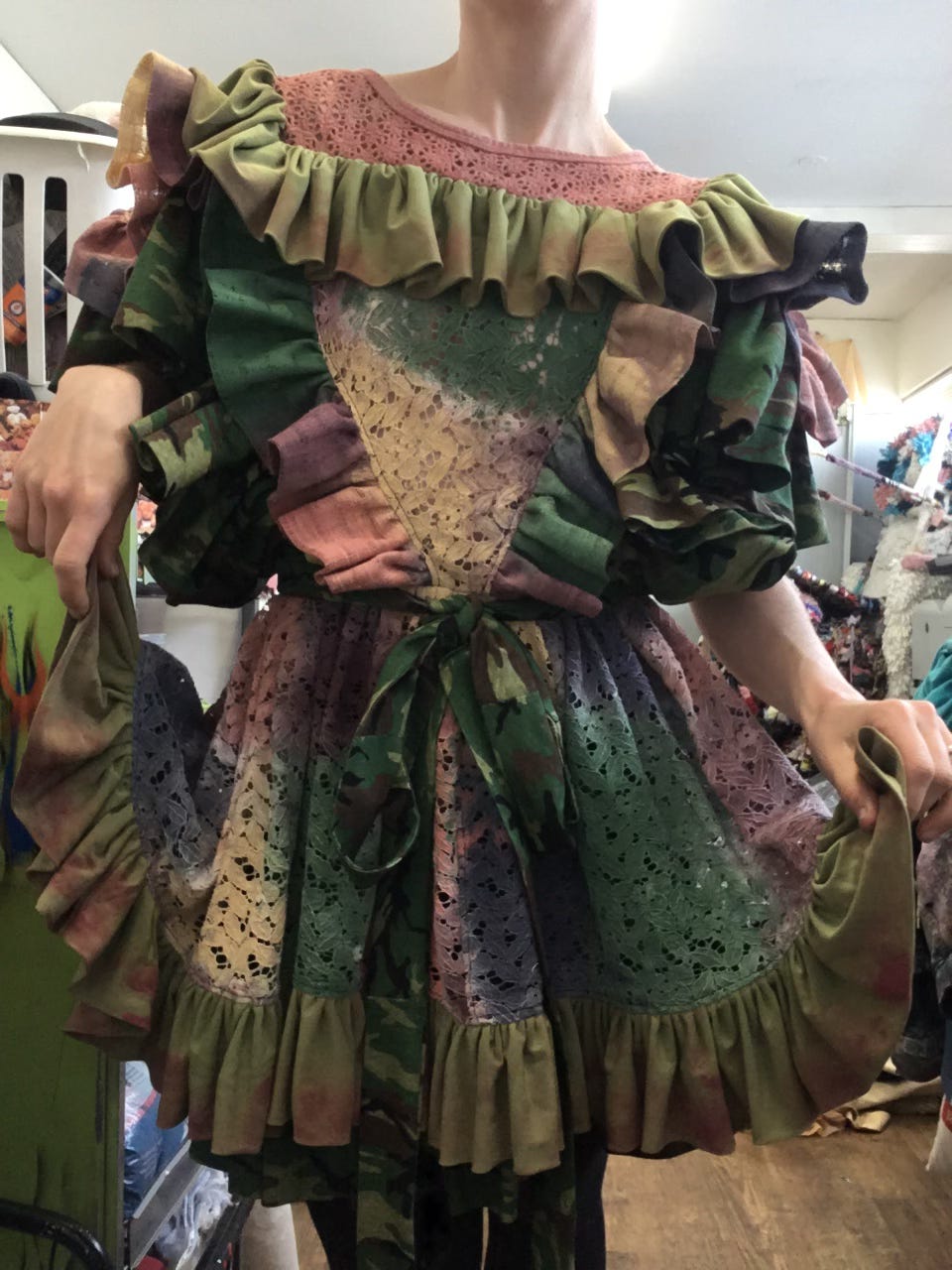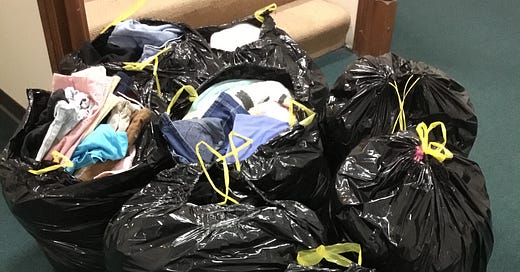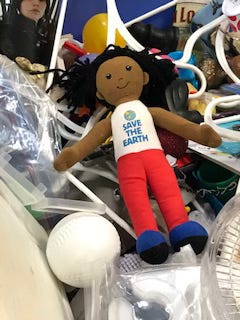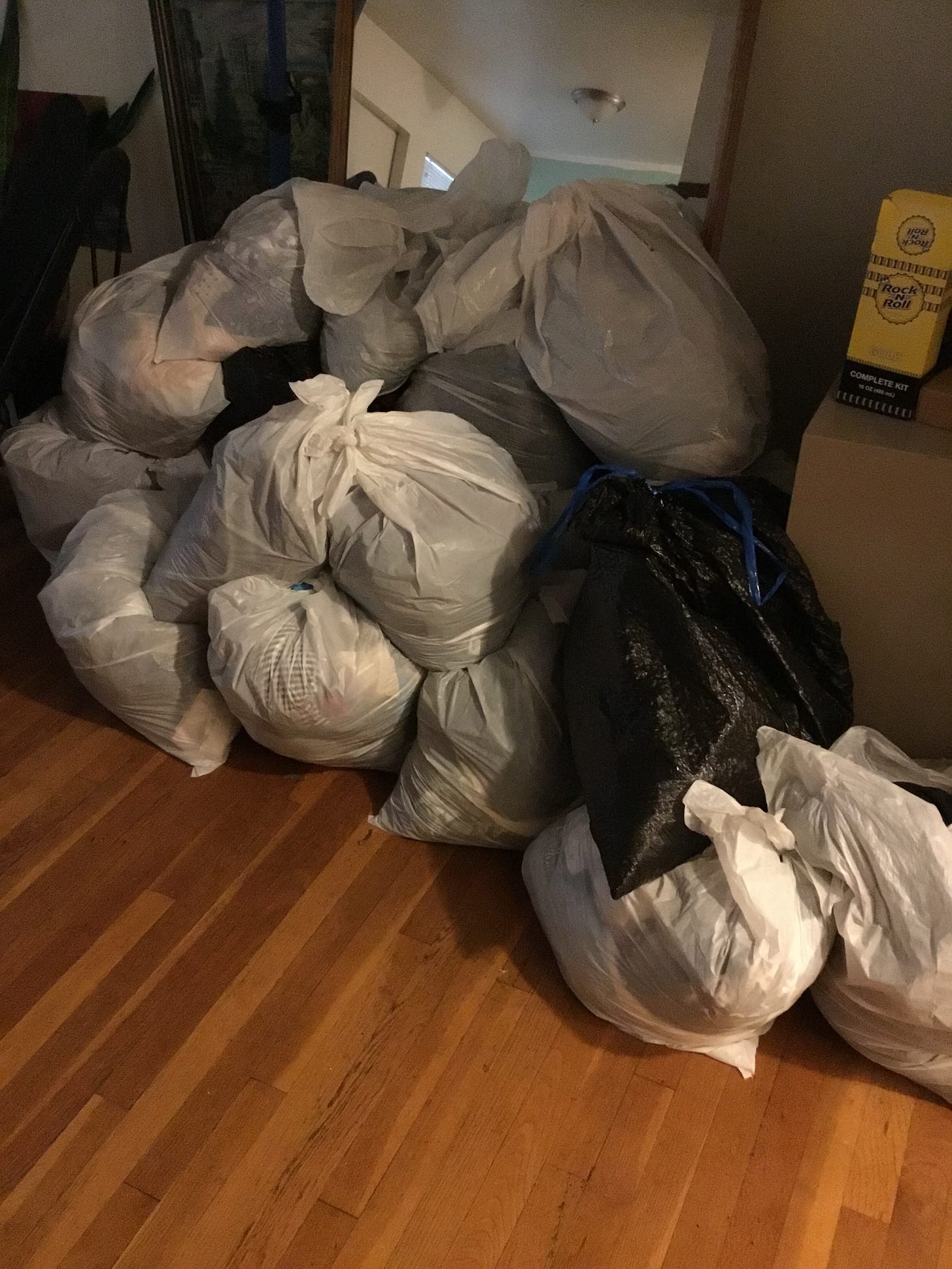PREAMBLE
Newly manufactured clothing need not exist. We’re living on a planet with enough clothing for the next six generations—and yet, over 100 billion garments are produced annually, and that number is only increasing. That’s a tough pill to swallow when you’re the daughter of garment manufacturers and an artist who makes clothing for a living. Though my parents' company is no longer in operation, my mom still works as a technical designer and I have multiple friends and relatives who are employed within the fashion industry. I don’t want the fashion industry to crash and burn. When clothing wears out, it will need to be replaced, hence new items will continue to be produced. I personally want to continue to create clothing as well (from reclaimed materials, of course), or at least that’s what I remind myself whenever I start to fall down a hole, drowning in the futility of it all. But regardless of whether or not we really, truly, actually need more newly manufactured clothing, hyper fast fashion brands like SHEIN will keep churning out product to the detriment of their workforce, our planet, and the artists whose designs they steal.
On a road trip through Central Washington last year, I talked with the owner of a massive, 2-story charitable thrift store in Wenatchee about her business. She said they were about to downsize to reduce their overhead but feared a smaller building would soon create a glaring disparity between available space and incoming donations, explicitly naming SHEIN as contributing to the unmanageability of her business. The textile recycling infrastructure in the United States is woefully inadequate. According to the EPA, “The recycling rate for all textiles was 14.7 percent in 2018, with 2.5 million tons recycled.” Our first defense in textile recycling, thrift stores, are buckling under the weight of non-stop donations. This isn’t a post-pandemic issue either. When “Tidying Up with Marie Kondo” came out in 2019, thrift stores reported an unmanageable influx of donations thanks to viewers participation in Kondo’s philosophy of only keeping things that ‘spark joy’. (NPR) Since the release of her book and Netflix show, it’s reported that Marie has “give up” on keeping her home tidy and clutter free, especially since having children. (The Guardian) And honestly, I’m glad to hear it. Only holding tight to things that ‘spark joy’ evades the emotional labor required to reconcile with the discomfort, confusion, or dissatisfaction some possessions might cause. Side-stepping this work only creates issues for others, in the same way that unresolved personal trauma becomes generational. What happens to all of our unwanted goods is often resolved through an act of Waste Colonialism, as defined by The Or Foundation:
Waste colonialism is when a group of people uses waste and pollution to dominate another group of people in their homeland. The fashion industry uses the global secondhand clothing trade as a de-facto waste management strategy, seeing three secondhand garments per person on the planet shipped across international borders and dumped into communities and ecosystems that lack the financial capacity to manage the waste. This is quite visible in the context of Accra’s Kantamanto Market, the largest secondhand market in the world. (Stop Waste Colonialism)
The OR Foundation has a variety of initiative, all of which emphasize place-based solutions which to me is key. I am located in Seattle, Washington, so for me, The More Clothes Manifesto is particular to where I live, which includes minutia like: my job, the size of my apartment and studio, the routes I travel, the thrift stores I frequent, the friends and family I have, and how all of these people, places, and things interact with fashion. The More Clothes Manifesto is my current belief about how to responsibly engage with clothing. I provide the following as a public declaration of my personal intentions and motivations for how and why I engage with clothing and textiles.
THE MORE CLOTHES MANIFESTO
CORE BELIEFS
It’s a public service to own more second hand clothing
It’s a public service to own your clothing for longer and wear more clothing simultaneously
It’s a public service to own more clothes made from clothes and support the artists who create them
DISCLAIMER: HOARDING VS STEWARDING
As a child of the Great Depression, my maternal grandmothers favorite mantras was “waste not want not”. In high school, I inherited her mother’s quilting scraps—only salvaged because my grandma then aunt had stored them for decades. I personally struggle to clearly defined a line between hoarding and stewarding. When does an act of respectful preservation become a trauma response? I tell myself, “It’s not hoarding if you’re an artist”. Whether or not that’s true, I consider it necessary for my work to store whatever materials comes my way; I see all the garments in my wardrobe as being carefully preserved for the future. Not everyone feels comfortable or finds it necessary to maintain this kind of stock, and that’s ok. I have developed systems for sorting all these garments which begins with:
Accepting and acquiring items from a place of intention, salvation, or desire
Assessing a garment’s position on the spectrum of perception
Investigating the potential a garment contains
Acting from a place of assumed responsibility in resolving a garment’s next destination
BELIEF 1
It’s a public service to own more second hand clothing
Action: Accept and acquire items from a place of intention, salvation, or desire
★
I tried Dialectical Behavior Therapy (DBT) in 2020 on advice of my therapist. As a modality, DBT provides tools for emotional regulation, interpersonal relationships, and mindfulness. One DBT tool that I’ve apply to my creative practice is radical acceptance. Regardless of my beliefs or desires concerning the future of fashion, the clothing that exists in our world today, exists. These clothes are here, and here to stay (unless they’ve been dumped and burned in the Atacama Desert, but that’s a different story). Walk into any retailer, thrift store, or browse online and it’s clear—there’s a lot of clothing out there, and it’s not going to magically disappear. I look down the street and imagine that every apartment, condo, townhouse, and home has one or more closets, dressers, and laundry baskets inside: all stuffed with clothes. I look at my own closet to see what I own, and consider how many pieces I’ve donated, sold, or swapped over the years—the world is utterly awash in clothing. For this reason, I believe it’s a public service to own more second hand clothing. Reclaiming more used clothing from friends, family, free boxes, thrift or consignment shops, vintage stores, and the like, equates to a reduction in local landfills and a reduction in stock bailed and sold in an act of waste colonialism. The focus of reclamation must be local. Otherwise, the dent I make as an individual compared to the global deluge is depressingly minuscule. The futility of the fight can then drive one into a nihilistic state of inaction, or worse, active complicity, which helps no one and no thing. When I lose sight of intention, I might want to give up on my mission, but act opposite (another DBT principle) guides me to reinvest, double down, and do more. Belief 1 comes with a commitment to self-monitored integrity. For me, it’s a righteous act to assume the burden of responsibility for how unfettered production and consumption orchestrated by the Global North negatively affects the rest of the world. Because if not me, then who? If not now, then when?
I find myself compelled to anthropomorphize clothing, whenever I’m riding my bike past a free box, walk into a thrift store, or cross paths with someone looking to rehome their clothing. I view clothing as possessing memories, lived experiences, desires, intentions, humanoid properties that turn the process of acquisition into an act of adoption. The orphaned clothing that is in my stead is not always permanently placed, but sometimes fostered instead. It’s at a point of transition and in need of validation, protection, and purpose. What a garment represents to me is the time, energy, labor, and natural resources that coalesced to create the thing in the first place. A garment is the embodiment of a garment workers precision and skill. To threat such a thing with reverence and respect, with intention and care, is to extend the same to its creator.
BELIEF 2
It’s a public service to own clothing for longer and wear more clothing simultaneously
Action: Assess a garment’s position on the spectrum of perception
★
A garment is a series of interconnected tubes with strategic openings to allow entrance and exit points for the body—a hole for the head, arms, torso, legs, etc. A garment can also be a flat panel with connection points like snaps, buttons, zippers, or ties, which allow the fabric to be wrapped around and secured to the body. The duties of a garment are simple, but ultimately, the meaning possessed by a garment exists on a spectrum which depends on one’s personal thoughts, feelings, desires, history, wants, and needs.
“My experience is what I agree to attend to. Only those items which I notice shape my mind.” - William James
People have told me that they’re “not into fashion” and I’m always shocked to see that these people are indeed, not nudists. Everyone is into fashion, whether consciously or not, The Devil Wears Prada spelled that out for us pretty succinctly. Everyone falls victim to fashion’s influence because we are all subject to its availability and history. Thus, there is a need to master one’s perception of clothing. Consider:
SPECTRUM OF PERCEPTION
Clothing as utility (an environmental, social, emotional shield)
Commonly, clothing is viewed through a lens of functionality. It protects us against exposure to the weather, the eyes of others, or even our own thoughts and feelings about our bodies.
Clothing as hierarchy
The hierarchy denoted by clothing has deep historical roots. Certain colors were once reserved for royalty because of a dyes’ rarity. Class divisions today are referred to as “blue-collar” vs. “white-collar” because low-middle class workers wore uniforms whereas upper-middle class wore suits. Designer handbags can signal status while knock-offs attempt to proximate. Clothing as hierarchy can thus signal and affirm or project and pretend.
Clothing as situational
Somewhere in between clothing as a shield and clothing as hierarchy, is clothing as situational. It divides functionality into categories of appropriate use: work clothes, lounge clothes, going-out clothes, work-out gear, knock-around clothes, and on. This may seem obvious but not everyone adheres to these kinds of divisions of use.
Clothing as self-expression
Sometimes mythical, sometimes factual, clothing can be used to express one’s inner-self to the outside world. Whether or not the message is received accurately is in the eye of the beholder.
Clothing as group identity
Clothing can signal a religious, political, geographical, cultural, or generational commitment. Sports fans wear team colors on game day. Millennial women only tuck in their shirts in the front. Buddhist monks wear robes. At times, clothing as self-expression is dually clothing as group identity, such as rebellious teenage styles like emo, scene, and mall goth.
Clothing as historical
20th-century technological advances in textiles production are taken for granted today. When Olivia Newton-John wore skin tight black pants in the finale of Grease, she had to be sewn into them because lycra leggings didn’t exist in 1978. Centuries of advances in textiles, construction, aesthetic, and so on, cement clothing as a valid means of historical exploration and education today.
Clothing as play
My personal favorite, clothing can be an adult adaptation of play dough, something to be molded, shaped, and sculpted into any imaginative form—different from a means of self-expression, this perspective is about an act of art creation and curation.
Ultimately, clothing is communication. It’s a language that’s both universal and personal. I am a selfish narrator in my dress. I don’t consider the way others might perceive or receive me, whereas some care deeply about how and what they communicate through their clothing. Understanding how the spectrum of perception applies to you will increase the longevity of the clothing in your closet; the most sustainable action in fashion is to hold onto your clothes for longer. I emphasis wearing more clothing simultaneously as another act of radically accepting the current state of over-production—validating the existence of clothing through increased use.
CLOSET THEORY
As an aside, perception can also be tied to disposition which I have broken down into three closet theories. I identify as a “Collector” which explains this manifesto:

Specialist
Your closet contains the modern basics: jeans and t-shirts, sweatshirts and sweatpants…
Most items are black, white, gray, blue, or neutral
You’re just a “normal kinda dude”
There’s at least one meme item in the mix, like an ugly Christmas sweater, reserved only for special occasions
Curator
Your closet has a unified theme or color palette with very few aberrations
Pieces are easily mixed and matched together to create distinct looks appropriate for any occasion
You’re in search of a “capsule collection” to last a lifetime and choose items quality construction
Where your clothing might be considered “timeless”, you may have a flair for the dramatic or trendy in accessories such as shoes, bags, and jewelry
Collector
Your closet might as well belong to a dozen different people
A multitude of styles, aesthetics, utilities, sizes and decades co-exist
Not everything “goes together”, but with the right series of components, you can make the most disparate combination coherent
You own a lot because you wear a lot and that’s ok!
BELIEF 3
It’s a public service to own more clothes made from clothes and support the artists who create them
Action: Investigate the potential a garment contains and act from a place of assume responsibility to resolve the garment’s next destination
★
I struggle with “buy nothing” initiatives. I say this because I both support and loath them. Yes, buy no new, but also, buy work from small makers who are actively and intentionally creating in order to resolve the issues of over-production and consumption perpetuated by those who do not adhere to the buy nothing trend. Because ultimately, that’s what a “buy nothing week” or month or year is: it’s a trend. And like a trend, it comes and it goes. When it goes, the resolution isn’t to buy only from artists or artisans or makers or craftspeople or upcyclers or salvagers or thrift. The resolution is often reversion. How many people who took everything that “didn’t spark joy” and dumped it at the doorstep of Goodwill six years ago, are today holding onto a bunch of random, aggravating junk again? If change is made merely from an external prompt, that change likely won’t remain. Long-lasting change comes from internal motivation and maintenance. This is why I have, over time, come to accumulated additional titles for myself beyond “artist” and “designer”. I am now a “clothing historian”, a “clothing steward”, and a “clothing processor”. The way I perceive, acquire, maintain, and rework clothing have become elemental to my identity, like little mosaic pieces that form a greater whole. This is a way of my life. When I see others whose work resonates with these convictions, I am compelled to support them in our common cause. Anyone who reworks the old into new is participating in harm-reduction. They are reducing the harm unresolved product can have on the planet and people both near and worlds away. If these makers do not receive support, they will not be able to continue to make. The tipping point nosedives where hustle becomes burnout or sellout.
As an artist creating new from the old, the clothing I collect is meticulously sorted:
CLOTHING IN MY CLOSET
I store to preserve history
Hanging Garments are organized by color and consist of: historical pieces, materials that wrinkle, pieces made by other artists, bulky items, sets, etc. These items I always hang back up after wearing to ensure their quality and longevity.
I store to embody play
Bags of Clothes are sorted by color and function like dress up boxes. I find it easier to style a look when I can throw things on the floor and mess around until I amass the right combination. I also have bags or boxes for under garments/socks, athletic tops/bottoms, tights, hats, handbags, and shoes.
I store to extend use
Laundry Basket contain work/lounge tops and bottoms that I actively seek to gather evidence of wear on their surface with paint, stains, rips and holes.

CLOTHING IN MY STUDIO
I sort to validate thru unique unions
The Floor is where I house materials for immediate use which have been curated for a specific collection. These materials are subject to resorting with culled items relocated to any of the following locations.
The Table is where I’ve cued up material for my next collection including: multiple large bags of all white garments, all black garments, vintage curtains, and deadstock bolts of fabric.
I sort to maximize use
The Closet is where I house curated bags of clothes and material for future collection, past work, on-going projects like my “365” t-shirt collection, and other things I’ve forgotten about but will find at a later date when I haul everything out to reorganize again.
The Bins are sorted into “textile collections” which are small groupings of curated materials, “notions” for ribbons, trims, and the like, and another bin for special or heirloom textiles that individuals have donated to me which I want to use with intention but have yet to design a project around.
I sort to share the wealth
The Hall is where I store several bags of clothes and shoes sourced from clothing swap left overs. These are materials available for other artists to pull from and a source for future JRAT projects.
When I purge, items are sorted yet again:
Some are sold because they’re quality vintage and I want to ensure they’ll be preserved by their next steward
Some are stored at my studio and sorted into the stations noted above
Some are shared with friends and family
Some are saved because they need mending or emotional resolution

There is intention, reason, and tenderness invested into every decision within the process of how clothing comes in and out of my stead. The price of the clothing I create from clothing is intended to reflect these layers of labor imbued within my work. Supporting other artists who embody a similar mission is imperative to maintaining a thriving, productive workforce committed to resolving post-consumer waste.
POSTSCRIPT
This is a manifesto, not a mandate. I can say something incendiary like, “minimalism is denialism; the More Clothes Manifesto is reality” but it doesn’t make that statement purely factual or fiction. It’s an opinion spurred by a hallucination—if we all got rid of everything we own, everything we own would choke out the world. We’d be wading through clothes in the ocean, driving over dishes in the street, and hiking through forests of furniture. I strongly believe that finding more appropriate means for living with the material world and supporting individuals who dedicate their life to this pursuit is an environmental imperative. There are countless limitations, however, that might prevent someone from fully embracing this kind of paradigm shift:
Financial Limitations
You might not have the money to acquire
Spatial Limitations
You might not have space to steward en mass
Physical Limitations
You might struggle to find things that fit
Creative Limitations
You might not have the skill/interest to transform
To name a few—and that’s ok. The More Clothes Manifesto is for me: a bandage on a gushing wound. I merely share it with you as a way to expose the gears that churn the inner workings of my art practice as well as hold myself accountable, publicly, to the level of artistic integrity which I strive to maintain. The embodiment of the More Clothes Manifesto is about striking a balance between my best interest vs. the greater good of this vast and unmanageable material world which I call home.







Yesss, this is so real and spoke to me - I’m a “collector” of vintage/secondhand clothing who has onsold pieces over the years out of a sense of guilt of owning “too much”, only to miss them dearly for years afterwards. So I’ve started holding onto things of I feel their time will come again — clothing steward is such a nice way to think about this practice ❤️
This hits hard. I think I've been a unintentional follower of this manifesto for years now, thanks for putting it all out there!